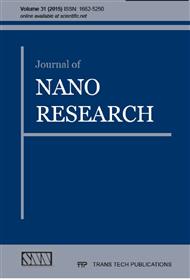[1]
Wei W., Jiang X., Lu L., Yang X. and Wang X., Study on the catalytic effect of NiO nanoparticles on the thermal decomposition of TEGDN/NC propellant., Journal of Hazardous Materials, vol. 168, pp.838-842, (2009).
DOI: 10.1016/j.jhazmat.2009.02.102
Google Scholar
[2]
K. Purushothaman and G. Muralidharan, The effect of annealing temperature on the electrochromic properties of nanostructured NiO films, Solar Energy Materials & SolarCells, vol. 93, p.1195–1201, (2009).
DOI: 10.1016/j.solmat.2008.12.029
Google Scholar
[3]
R. Palombari, Influence of surface acceptor /donor couples on conductivity and other electrochemical properties of nonstoichiometric NiO at 200°C, Journal of Electroanalytical Chemistry, vol. 546, pp.23-28, (2003).
DOI: 10.1016/s0022-0728(03)00134-7
Google Scholar
[4]
C. Cantalinia, M. Postb, D. Busoc, M. G. and A. M. , Gas sensing properties of nanocrystalline NiO and Co3O4, Sensors and Actuators B, vol. 108, pp.184-192, (2005).
Google Scholar
[5]
C. Luyoa et al., Gas sensing response of NiO nanoparticle films made by reactive gas deposition, Sensors and Actuators B, vol. 138, pp.14-20, (2009).
DOI: 10.1016/j.snb.2008.11.057
Google Scholar
[6]
Masahiko Matsumiya et al., Thin-film Li-doped NiO for thermoelectric hydrogen gas sensor, Thin Solid Films, vol. 419, pp.213-217, (2002).
DOI: 10.1016/s0040-6090(02)00762-9
Google Scholar
[7]
P. Poizot, S. Laruelle, S. Grugeon, L. Dupont and J. -M. Tarascon, Nano-sized transition-metal oxides as negative-electrode materials for lithium-ion batteries, Nature, vol. 407, pp.496-499, September (2000).
DOI: 10.1038/35035045
Google Scholar
[8]
S. Z. Khan, Y. Yuan, A. Abdolvand, M. Schmidt and P. Crouse, Generation and characterization of NiO nanoparticles by continuous wave fiber laser ablation in liquid, J Nanopart Res, vol. 11, no. 6, pp.1421-1427, November (2009).
DOI: 10.1007/s11051-008-9530-9
Google Scholar
[9]
Kaname Sakiyama, Kenji Koga, Takafumi Seto, Makoto Hirasawa and Takaaki Orii, Formation of Size-Selected Ni/NiO Core−Shell Particles by Pulsed Laser Ablation, The Journal of Physical Chemistry B, vol. 108, no. 2, pp.523-529, (2004).
DOI: 10.1021/jp035339x
Google Scholar
[10]
Ying Wu, Yiming He, Tinghua Wu, Weizheng Weng and Huilin Wan, Effect of synthesis method on the physical and catalytic property of nanosized NiO, Materials Letters, vol. 61, no. 13, pp.2679-2682, (2007).
DOI: 10.1016/j.matlet.2006.10.022
Google Scholar
[11]
F. Davara, Z. Fereshteh and M. Salavati-Niasari, Nanoparticles Ni and NiO: Synthesis, characterization and magnetic properties, Journal of Alloys and Compounds, vol. 276, no. 1-2, pp.797-801, (2009).
DOI: 10.1016/j.jallcom.2008.09.121
Google Scholar
[12]
C. B. Wang et al., Preparation and characterization of nanosized nickel oxide, Catalysis Letters, vol. 101, no. 3-4, pp.241-247, (2005).
Google Scholar
[13]
Ying Wu, Yiming He, Tinghua Wu, Tong Chen, Weizheng Weng and Huilin Wan, Influence of some parameters on the synthesis of nanosized NiO material by modified sol–gel method, Materials Letters, vol. 61, p.3174–3178, (2007).
DOI: 10.1016/j.matlet.2006.11.018
Google Scholar
[14]
C. T. Meneses et al., A simple route to the synthesis of high-quality NiO nanoparticles, Journal of Nanoparticle Research, vol. 9, pp.501-505, (2007).
Google Scholar
[15]
R. A. Young, The Rietveld method, International union of crystallography, Oxford university press, (1993).
Google Scholar
[16]
George will, Powder diffraction: The rietveld method and the two-stage method, springer, (2006).
Google Scholar
[17]
B. Axs, TOPAS V2. 1, User Manual, Karlsruhe, (2003).
Google Scholar
[18]
R. Newman and R. M. Chrenko, Optical properties of Nickel Oxide, Physical Review, vol. 114, no. 6, pp.1507-1513, (1959).
DOI: 10.1103/physrev.114.1507
Google Scholar
[19]
M. Pressl, M. Mayer, P. Knoll, S. Lo and U. Hohenster, Magnetic Raman scattering in Undoped and Doped Antiferromagnets, Journal of Raman Spectroscopy, vol. 27, pp.343-349, (1996).
DOI: 10.1002/(sici)1097-4555(199603)27:3/4<343::aid-jrs956>3.0.co;2-s
Google Scholar
[20]
P. A. Fleury and R. Loudon, Scattering of light by One and Two-magnon excitations, Physics Review, vol. 166, pp.514-530, (1968).
DOI: 10.1103/physrev.166.514
Google Scholar
[21]
T. UngaÂr, J. Gubicza, G. RibaÂrik and A. BorbeÂly, Crystallite size distribution and dislocation structure determined by diffraction profile analysis: principles and practical application to cubic and hexagonal crystals, Journal of applied crystallography, vol. 34, pp.298-310, (2001).
DOI: 10.1107/s0021889801003715
Google Scholar
[22]
Y. Shimomura, I. Tsubokawa and M. Kojima, On Nickel oxides of high oxygen content, Journal of physical society of Japan, vol. 9, no. 4, April (1954).
DOI: 10.1143/jpsj.9.521
Google Scholar


